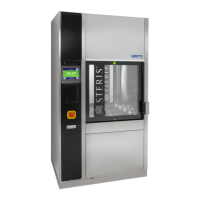
Do you have a question about the Steris AMSCO 7000 Series and is the answer not in the manual?
Provides essential information on the proper use and maintenance of the washer/disinfectors.
Highlights important safety precautions and intended use of the equipment.
Emphasizes preventive maintenance and contacting STERIS for service.
Lists general safety requirements met by the equipment in the EU.
Lists various immunity test standards applied to the equipment.
Lists emission test standards applied to the equipment.
Explains the importance of observing safety precautions for safe equipment operation.
Lists critical warnings and guidelines for preventing injury and equipment damage.
Defines common symbols found on the washer/disinfector components.
Defines symbols found on the equipment's identification nameplate.
Explains symbols related to equipment transport and storage conditions.
Introduces the major components and controls of the washer/disinfector.
Details the operation and safety features of the sliding chamber doors.
Details the chemical dosing system and pump configuration.
Explains the washer/disinfector control system, modes, and touch screens.
Details capabilities for modifying parameters and settings.
Explains the touch-sensitive screens and their functions.
Details the printer's function for logging cycle data and malfunctions.
Describes the bar code reader for scanning data before cycles.
Explains the function of emergency stop pushbuttons for immediate shutdown.
Describes the safety feature preventing simultaneous door opening.
Details the optional system for automated loading/unloading.
Explains the advanced system for automating loading/unloading processes.
Provides guidelines for loading items into the washer/disinfector.
Describes accessories for securing small items and trays.
Details racks for various instrument types and general use.
Describes specialized manifold racks for MIS, Ophthalmic, and Anesthesia instruments.
Provides instructions for connecting cannulated instruments to flexible hoses.
Lists recommended practices for connecting flexible hoses and instruments.
Lists practices to avoid when connecting flexible hoses and instruments.
Recommends specific chemicals for processing loads in the washer/disinfector.
Mentions other STERIS chemicals that can be used with the washer/disinfector.
Introduces operating procedures and safety warnings.
Lists checks and preparations required before operating the washer/disinfector.
Provides guidelines for manually loading items into the washer/disinfector.
Details the steps involved in a typical cycle operation.
Guide on how to respond to alarms and system warnings.
Steps for properly shutting down the washer/disinfector.
Details on operating the chamber doors and safety features.
Introduces cycle programming, factory-preset cycles, and treatments.
Lists the various menus accessible within Supervisor mode.
Used for creating and modifying customized cycles.
Guide for transferring cycle reports to a USB key.
Allows modification of features like machine ID, standby delay, and drain extension.
Procedure for changing the supervisor password.
Procedure for setting names for chemical injection pumps.
Guide for priming the chemical pumps.
For setting units for injection, temperature, and pressure.
For enabling/disabling printer and extended printout features.
For setting the current date and time.
For selecting the operating language.
For viewing information about the software version.
Instructions for formatting USB keys to FAT32 for compatibility.
Emphasizes the importance of regular preventive maintenance.
Provides a checklist for routine maintenance tasks performed by the operator.
Procedure for cleaning the water outlet connection.
Steps for running the DECONTAMINATION cycle for cleaning and descaling.
Procedure for replacing chemical containers.
Instructions for replacing printer paper and ink cartridges.
Steps for inspecting and cleaning spray arms for 7052HP model.
Steps for cleaning spray arms for 7053HP model.
Procedure to perform the door safety test.
Procedure to perform the sump safety level test.
Procedure to test water inlet pressure and temperature.
Steps to verify the operation of Emergency Stop pushbuttons.
Introduces the troubleshooting section and safety precautions.
Addresses abnormal conductivity readings during thermal rinse draining.
Addresses warnings related to low air pressure during cycles.
Troubleshooting for issues with chamber draining.
Reminder and procedure for cleaning the sump filter.
Troubleshooting for a blank display or unresponsive touch pads.
Reminder for performing the door safety test.
Warning for excessive foaming during pre-wash phase.
Troubleshooting for excessive foam within the chamber.
Troubleshooting for paper not being taken up by the printer.
Troubleshooting for a non-functional printer.
Troubleshooting for loads coming out dirty after a cycle.
Troubleshooting for loads coming out wet at the end of a cycle.
Reminder for scheduling preventive maintenance.
Troubleshooting for cycles stopping without apparent cause.
Alarm when pump starts before water level is reached.
Warning for a leaking rinse reservoir.
Reminder for sump safety level test.
Error message when water inlet pressure test fails.
Troubleshooting for an unresponsive touch screen.
Alarm indicating the load door is open during a process.
Alarm when sump water level is not reached within the allowed time.
Alarm when sump temperature exceeds maximum allowed.
Alarm when pump does not start after activation.
Alarm when chemical volume monitored is too low.
Lists consumable items like paper rolls, ink cartridges, and filters.
Information on how to find and order replacement parts.